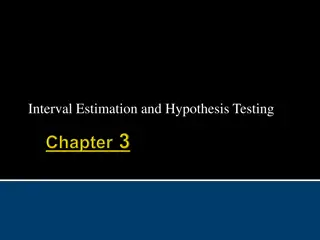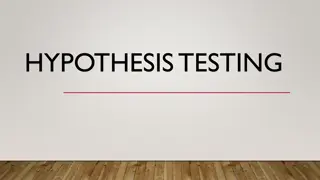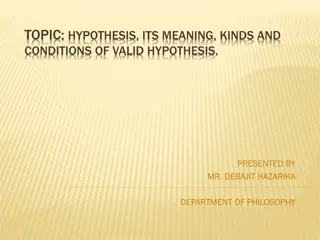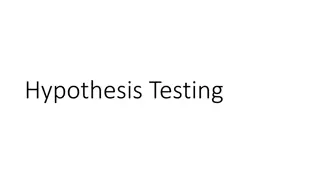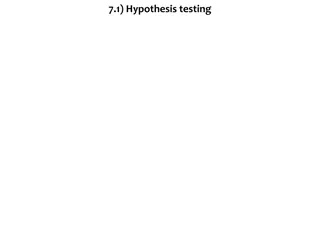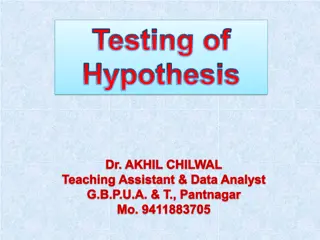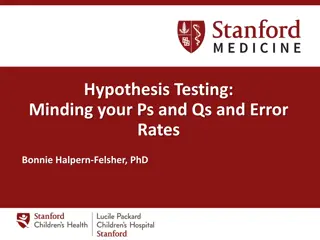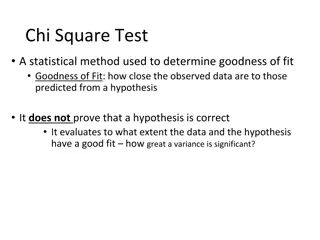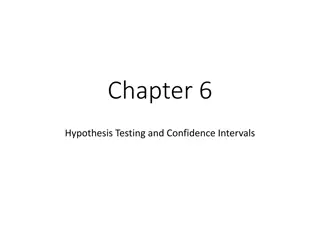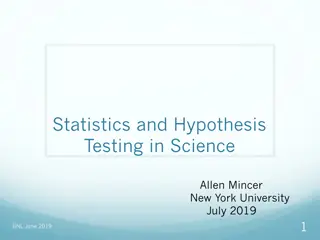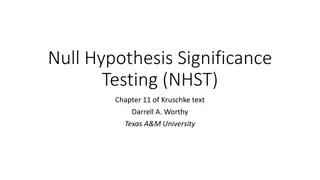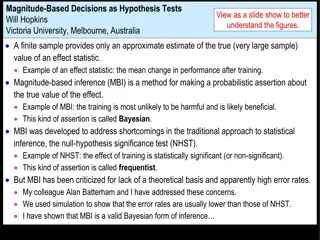Understanding Hypothesis Testing in Statistics
Explore the concept of hypothesis testing through an engaging scenario involving Edison light bulbs. Learn about factors influencing hypothesis testing such as variability, sample size, and sample mean. Discover the logic behind hypothesis testing using Jake's napkin dispensers example. Enhance your statistical knowledge and skills in testing research hypotheses effectively.
Download Presentation

Please find below an Image/Link to download the presentation.
The content on the website is provided AS IS for your information and personal use only. It may not be sold, licensed, or shared on other websites without obtaining consent from the author. Download presentation by click this link. If you encounter any issues during the download, it is possible that the publisher has removed the file from their server.
E N D
Presentation Transcript
HYPOTHESIS TESTING
Edison Light Bulbs: What affects hypothesis testing? Do in class??? Taking this class has made you intellectually curious (I m serious!). So, you decide to see whether Edison light bulbs last as long as the package says they do; according to the package: = 1200 hr and = 180 hr. Along with your physics major roommate, you construct a bank of 100 light bulbs and watch them round the clock to see when they burn out. The mean of your sample is 1170 hours. Does this constitute evidence of consumer fraud by Edison light bulbs if = .05? M 1170 1200 30 Zobs = = = = . 1 67 0 18 / 180 / 100 n If we set alpha at .05 then Z crit = 1.96 We will fail to reject fail to reject the null
What affects the hypothesis test? 1. Variability (SE): smaller will make you more likely to reject the null Do in class??? Example: We sample 100 Big Y light bulbs to determine if they last as long as the package claims: 1200 hours. M = 1170 = 150 (instead of 180) What is the probability that we get this sample from a population with a mean of 1200? ( / n If we set alpha at .05 then Z crit = 1.96 We will reject will reject the null M 1170 1200 ) ( 150 ) = = = 2 z 0 / 100
What affects the hypothesis test? 2. Sample size: the larger the sample size, the more likely we are to reject Do in class??? Example: We sample 225 (rather than 100) Big Y light bulbs to determine if they last as long as the package claims: 1200 hours. M = 1170 = 180 (back to original) What is the probability that we get this sample from a population with a mean of 1200? z=M -m0 s / n ( If we set alpha at .05 then Z crit = 1.96 We will reject will reject the null =1170-1200 =-2.5 ) 180/ 225 ( )
What affects the hypothesis test? Do in class??? 3. Sample mean: farther it is from the null mean, the more likely we are to reject Example: We sample 100 (back to original)Big Y light bulbs to determine if they last as long as the package claims: 1200 hours. M = 1140 (rather than 1170) = 180 (back to original) What is the probability that we get this sample from a population with a mean of 1200? ( / M 1140 1200 ) ( 180 ) = = = . 3 33 z 0 / 100 n If we set alpha at .05 then Z crit = 1.96 We will reject will reject the null
The logic of hypothesis testing Jake s napkin dispensers Ho: = 100 Ha: 100 Collect a sample of data and compare it with the two hypotheses. What would you conclude if his sample mean was: 99.8 pounds? 97 pounds? 95 pounds? 90 pounds? At some point, the sample mean would be so far from 100, that we could not believe the null hypothesis was true.
HW#2: Question 3 A researcher examines the relationship between delinquent behaviors and poor verbal abilities in teenagers. They administer a verbal IQ test to a sample of 81 incarcerated juvenile delinquents, you find that the sample mean verbal IQ is 103. The verbal IQ test is known to have a = 107 and a = 15 in the general population of teenagers. Assuming that the population mean and SD for juvenile delinquents is the same as that for the general population of teenagers, what is the probability of selecting a sample with a mean of 103 or lower? Do you think that juvenile delinquents have the same population mean and SD for verbal IQ as the general population of teenagers? Explain your answer.
HW#2: Question 3 A researcher examines the relationship between delinquent behaviors and poor verbal abilities in teenagers. They administer a verbal IQ test to a sample of 81 incarcerated juvenile delinquents, you find that the sample mean verbal IQ is 103. The verbal IQ test is known to have a = 107 and a = 15 in the general population of teenagers. Assuming that the population mean and SD for juvenile delinquents is the same as that for the general population of teenagers, what is the probability of selecting a sample with a mean of 103 or lower? Do you think that juvenile delinquents have the same population mean and SD for verbal IQ as the general population of teenagers? Explain your answer.
HW#2: Question 3 A researcher examines the relationship between delinquent behaviors and poor verbal abilities in teenagers. They administer a verbal IQ test to a sample of 81 incarcerated juvenile delinquents, you find that the sample mean verbal IQ is 103. The verbal IQ test is known to have a = 107 and a = 15 in the general population of teenagers. Assuming that the population mean and SD for juvenile delinquents is the same as that for the general population of teenagers, what is the probability of selecting a sample with a mean of 103 or lower? Do you think that juvenile delinquents have the same population mean and SD for verbal IQ as the general population of teenagers? Explain your answer.
Visually =? =107 Ho : =107 HA: 107
How do we do this? Calculate the probability of getting our sample mean (given n and s) IF the null hypothesis is TRUE In other words, given that our sample mean was 103, how likely is it that we could have obtained a sample with a mean of 103 (with n = 81; s = 15) if the mean of the population was 107? Less than 1% Which means there is a 99% that the population mean was something OTHER than (in this case less than) 107
Examine Sampling Distribution for the null hypothesis
Assuming the Null Hypothesis is True Why do we assume the null hypothesis is true? We will only reject the null hypothesis if the probability of obtaining our sample mean is below some threshold. What is that threshold and who gets to decide?
We never accept the null Statisticians are conservative Professor Hobbes and his suspected cheaters: HO: The two students DID NOT HA: The two students DID If the evidence of cheating was suspicious, but not strong enough for a formal accusation, would Hobbes: Accept the null? Fail to reject the null? DID NOT cheat. DID cheat. Statisticians are cautious a. Is the earth flat? b. Are there cows with giant holes in their sides? On your own time, google fistulated cow.
Hypothesis Testing Errors Reality H0 is True H0 is False TYPE I ERROR ( ) Reject H0 Correct Rejection Result of Test TYPE II ERROR ( ) Fail to Reject H0 Correct FTR Type I Error Type I Error: rejectingthe null even though (in reality) it is true; P (Type I error) = . Type II Error Type II Error: failing to reject the null even though (in reality) it is false. P (Type II error) = Questions Questions: Which error type concerns statisticians more? Why?
Why not make alpha as small as possible? If null is true: If null is true: any sample mean in this range will lead us to erroneously reject the null
Why not make alpha as small as possible? If null is false: If null is false: any sample mean in this range will lead us to erroneously fail to reject the null
Why not make alpha as small as possible? If null is false: If null is false: any sample mean in this range will lead us to erroneously fail to reject the null
Identifying the null and alternative hypotheses 60% of college students have had a drink in the past month (according to a study I read on the internet which is super reliable). I want to know how AC students rate of alcoholic consumption compares to that value. What is the Null Hypothesis for this question? What is the Alternative Hypothesis for this question? Please answer both questions in English and using statistical notation (e.g., )
Identifying the null and alternative hypotheses I want to know if Amherst College students are as harsh as (could be more harsh could be less harsh) as the subjects in Eskine, et al. (2007). What is the Null Hypothesis for this question? What is the Alternative Hypothesis for this question? Please answer both questions in English and using statistical notation (e.g., )
Conducting a hypothesis test I want to know if alcohol consumption changed in 2020 as a result of the VTSNBN . What is the Null Hypothesis for this question? What is the Alternative Hypothesis for this question? Conduct the appropriate test using the data below. Total Total Beer Beer Wine Wine Spirits Spirits 2020 2020 Mean 1258885 419357 547043 290483 Total Total Mean 1251279 442376 503967 304936 (n=47) (n=47) Std. Dev 230117 69138 140800 66856
Total Total Total Beer Beer Wine Wine Spirits Spirits 2020 2020 Mean 1258885 1258885 419357 547043 290483 Total Total Mean 1251279 1251279 442376 503967 304936 (n=47) (n=47) Std. Dev 230117 230117 69138 140800 66856 Critical value for Z: Zcrit = 1.96 ? =? ? =1258885 1251279 230117 = 7606 33566= 0.23 ? ? 47 Decision regarding the null? What does the decision tell us about total alcohol consumption during the COVIDs?
Beer Total Total Beer Beer Wine Wine Spirits Spirits 2020 2020 Mean 1258885 419357 419357 547043 290483 Total Total Mean 1251279 442376 442376 503967 304936 (n=47) (n=47) Std. Dev 230117 69138 69138 140800 66856 Critical value for Z: Zcrit = 1.96 ? =? ? =419357 442376 69138 = 23018 10084= 2.28 ? ? 47 Decision regarding the null? What does the decision tell us about beer consumption during the COVIDs?
Wine Total Total Beer Beer Wine Wine Spirits Spirits 2020 2020 Mean 1258885 419357 547043 547043 290483 Total Total Mean 1251279 442376 503967 503967 304936 (n=47) (n=47) Std. Dev 230117 69138 140800 140800 66856 Critical value for Z: Zcrit = 1.96 ? =? ? =547043 503967 140800 = 43076 20538= 2.10 ? ? 47 Decision regarding the null? What does the decision tell us about wine consumption during the COVIDs?
Spirits Total Total Beer Beer Wine Wine Spirits Spirits 2020 2020 Mean 1258885 419357 547043 290483 290483 Total Total Mean 1251279 442376 503967 304936 304936 (n=47) (n=47) Std. Dev 230117 69138 140800 66856 66856 Critical value for Z: Zcrit = 1.96 ? =? ? =290483 304936 66856 = 14452 9752 = 1.48 ? ? 47 Decision regarding the null? What does the decision tell us about spirits consumption during the COVIDs?


